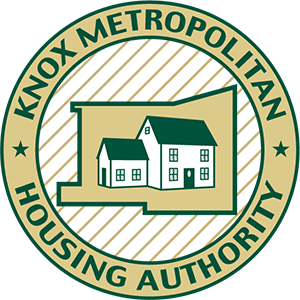Housing Choice Voucher Program
Housing Quality Standards Guidelines
Having a good place to live is important. KMHA and the Section 8 Housing Choice Voucher Program will help you with this process. You are free to choose any house or apartment you like, as long as it meets program requirements for quality.
The Requirements: Every house or apartment must have at least a living room, kitchen, and bathroom. A one-room efficiency apartment with a kitchen area is alright. However, there must be a separate bathroom for the private use of your family. Generally there must be one living/sleeping room for every two family members.

Outside handrails – Secure handrails on any extended length of stairs (four or more steps) and any porches, balconies, or decks that are 30 inches or more above the ground.
Walls – Exterior wall that are in good condition, with no large holes or cracks that would let a great amount of air inside.
Foundation – A foundation in good condition that has no serious leaks.
Water Supply - A plumbing system that is connected to an approvable public or private water supply system.
Sewage - A plumbing system that is connected to an approvable public or private water supply system.
Chimneys - No serious leaning or defects (such as big cracks or missing bricks) in any chimneys.
Paint - No peeling or chipping paint if you have children under the age of six and the house or apartment was built before 1978. This includes exterior walls, stairs, decks, porches, railings, windows, outbuildings and doors.
Cooling - Some windows that open or some working ventilation or cooling equipment that can provide air circulation during warm months.
Plumbing - Pipes that are in good condition, with no leaks and no serious rust that causes the water to be discolored.
Water Heater - A water heater located, equipped and installed in a safe manner along with a discharge line that extends to within six inches of the floor.
Heat - Enough heating equipment so that the unit can be made comfortably warm during cold months. Not acceptable are space heaters (or room heaters) that can burn oil or gas and are not vented to a chimney. Space heaters that are vented may be acceptable if they can provide enough heat.
Smoke Detectors – At least one working smoke detector on each level of the unit, including the basement. If any member of your family is hearing impaired, the smoke detector must have an alarm designed for hearing impaired persons.
Fire Exits – The building must provide an alternate means of exit in case of fire (such as fore stairs or exit through windows, with the use of a ladder if windows are above the second floor).
Elevators – Make sure the elevators are safe and work properly.
Entrance – An entrance from the outside of from a public hall, so that it is not necessary to go through anyone else’s private apartment to get into the unit.
Neighborhood - No dangerous places, spaces, or things in the neighborhood such as:
- Nearby buildings that are falling down
- Unprotected cliffs or quarries
- Fire hazards
- Evidence of flooding
Garbage - No large piles of trash and garbage inside or outside of the unit, or in common areas such as hallways. There must be a space to store garbage (until pickup) it must be covered tightly so that rats and other animals cannot get into it. Trash should be picked up regularly.
Lights - Lights that work in all common hallways and interior stairs.
Stairs and Hallways - Interior stairs with railings, and common hallways that are safe and in good condition. Minimal cracking, peeling, or chipping in these areas.
Plumbing - Pipes that are in good condition, with no leaks and no serious rust that causes the water to be discolored.
Pollution - No serious air pollution such as exhaust fumes or sewer gas.
Rodents or Vermin - No sign of rats or large numbers of mice or vermin (like roaches).
Manufactured Home: Tie Downs - Manufactured homes must be placed on site in a stable manner and be free from hazards such as sliding or wind damage.
Not acceptable are large cracks or holes that allow drafts, severe bulging, large amounts of loose or falling surface material such as plaster.
Walls – Walls that are in good condition.
Not acceptable are large cracks or holes that allow drafts, severe bulging or leaning, large amounts of loose or falling surface material such as plaster.
Electricity – At least two electric outlets, or one outlet and one permanent overhead light fixture. Do not count table or floor lamps, ceiling lamps plugged into a socket, and extension cords: they are not permanent.
Not acceptable are broken or frayed wiring, light fixtures hanging from wires with no other firm support (such as a chain), missing cover plates on switches or outlets, badly cracked outlets.
Outlets shall be tested for proper grounding, if installing GFCI’s make sure they operate correctly.
Floor – A floor that is in good condition.
Not acceptable are large cracks or holes, missing or warped floorboards or covering that could cause someone to trip.
Windows – At least one window. Every window must be in good condition.
Not acceptable are windows with badly cracked, broken or missing panes, and windows that do not shut or, when shut, do not keep out the weather.
Lock – A lock that works on all windows and doors that can be reached from outside, a common public hallway, a fire escape, porch or other outside place that cannot be reached from the ground. A window that cannot be opened is acceptable.
Paint – No peeling or chipping paint if you have children under the age of six and the house or apartment was built before 1978.
Not acceptable are large cracks or holes that allow drafts, severe bulging, large amounts of loose or falling surface material such as plaster.
Storage – Some space to store food.
Electricity – At least one electric outlet and one permanent light fixture. Do not count table or floor labels, ceiling lamps plugged into a socket and extension cords. They are not permanent.
Not acceptable are broken or frayed wiring, light fixtures hanging from wires with no other firm support (such as a chain), missing cover plates on switches or outlets, badly cracked outlets.
Stove and Oven - A stove (or range) and oven that works (This can be supplied by the tenant)
Floor – A floor that is in good condition.
Not acceptable are large cracks or holes, missing or warped floorboards or covering that could cause someone to trip.
Preparation Area - Some space to prepare food.
Paint - No peeling or chipping paint if you have children under the age of six and the house or apartment was built before 1978.
Window – If there is a window, it must be in good condition.
Lock – A lock that works on all windows and doors that can be reached from outside, a common public hallway, a fire escape, porch or other outside place that cannot be reached from the ground. A window that cannot be opened is acceptable.
Walls – Walls that are in good condition.
Not acceptable are large cracks or holes that allow drafts, severe bulging or leaning, large amounts of loose or falling surface material such as plaster.
Serving Area - Some space to serve food.
A separate dining room or dining area in the living room is alright
Refrigerator - A refrigerator that keeps temperatures low enough so that food does not spoil. (This can be supplied by the tenant)
Sink - A sink with hot and cold running water.
A bathroom sink will not satisfy this requirement.
Not acceptable are large cracks or holes that allow drafts, severe bulging, large amounts of loose or falling surface material such as plaster.
Window – A window that opens or a working exhaust fan.
Lock – A lock that works on all windows and doors that can be reached from outside, a common public hallway, a fire escape, porch or other outside place that cannot be reached from the ground. A window that cannot be opened is acceptable.
Toilet – A flush toilet that works.
Tub or shower – A tub or shower with hot and cold running water.
Floor - A floor that is in good condition.
Not acceptable are large cracks or holes, missing or warped floorboards or covering that could cause someone to trip.
Paint – No peeling or chipping paint if you have children under the age of six and the house or apartment was built before 1978.
Walls – Walls that are in good condition.
Not acceptable are large cracks or holes that allow drafts, severe bulging or leaning, large amounts of loose or falling surface material such as plaster.
Electricity – At least one permanent overhead or wall light fixture.
Not acceptable are broken or frayed wiring, light fixtures hanging from wires with no other firm support (such as a chain), missing cover plates on switches or outlets, badly cracked outlets.
Outlets shall be tested for proper grounding, if installing GFCI’s make sure they operate correctly.
Sink – A sink with hot and cold running water.
A kitchen sink will not satisfy this requirement.
Housing quality standards help to insure that your home will be safe, healthy, and comfortable. In the Section 8 Housing Voucher Program there are two kinds of housing quality standards. Things that a home must have in order to be approved by the PHA, and additional things that you should think about for the special needs of your own family. These are items that you can decide.
THE SECTION 8 HOUSING VOUCHER PROGRAM
The Section 8 Housing Voucher Program allows you to choose a house or apartment you like. It may be where you are living now or somewhere else. The must have standards are very basic items that every apartment must have. But a home that has all of the must have standards may still not have everything you need or would like. With the help of Section 8 Housing Voucher Program, you should be able to afford a good home, so you should think about what you would like your home to have. You may want a big kitchen or a lot of windows or a first floor apartment. Worn wallpaper or paint may bother you. Think of these things as you are looking for a home. Please take the time to read A Good Place to Live. If you would like to stay in your present home, use this booklet to see if your home meets the housing quality standards. If you want to move, use it each time you go to look for a new house or apartment, and good luck in finding your good place to live.
Read each section carefully. After you find a place to live, you can start the Request for Lease Approval process. You may find a place you like that has some problems with it. Check with your PHA about what to do, since it may be possible to correct the problems.


